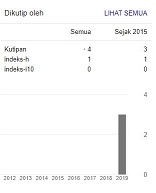Eksplorasi Faktor-Faktor Yang Mempengaruhi Kepuasan Nasabah: Sebuah Kerangka Penelitian Terpadu Untuk Perbankan
Abstract
Keywords
Full Text:
PDFReferences
Anderson, J.C. & Gerbing D.W. (1988). Structural equation modeling in practice: a review and recommended two step approach.
Psychological Bullentin, 103,411-423.
Ata, U.Z., & Toker, A. (2012). The effect of customer relationship management adoption in business-to-business markets. Journal of Business & IndustrialMarketing, 27(6),497-507.
Bentler, P.M and Chou, .P. (1987). Practical issues in structural modeling. Sociological Methods and Research 16, 78-117.
Bloemer, J., Ruyter, K.D., & Peeters,
P. (1998). Investigating drivers of bank loyalty: the complex relationship between image, service quality and satisfaction. International Journal of Bank Marketing, 16 (7), 276-286.
Chou, S.Y., Trappey., Pokojski., & Smith. (2009). Global Perspective for Competitive Enterprise, Economy and Ecology: Proceedings of The 16th ISPE International Conference on Concurrent Engineering. London: springer Dordrecht Heidelberg London New York.
Chowdhury, M.M.H. (2011). Ethical issues as competitive advantage for bank management. Humanomics, 27 (2), 109-120.
Daft, R., Kendrick, M., & Vershinina,N. (2010). Management. UK: Cengage Learning EMEA.
Egan, J. (2007). Marketing Communications. London: Thomson Learning.
Eng, T.Y. (2011). Six Sigma: insights from organizational innovativeness and market orientation, International Journal of Quality & Reliability Management, 28 (3), 252-262.
Goldenberg, B.J. (2008). CRM in Real Time Empowering Customer Relationship. First Edition. USA: Library of Congress Cataloging- in-publication Data.
Griffin, R.W. (2008). Fundamentals of
Management. Fifth Edition. USA: Cengage Learning, Inc.
Hooper, D., J. Coughlan, & M.R. Mullen, (2008). Structural Equation Modelling: Guidelines for Determining Model Fit,” The Electronic Journal of Business Research Methods, 6 (1), 53-60.
Kaplan, D. (2000). Structural Equation Modeling Foundation and Extensions. London: Sage publication.
Khan, M.H.U.Z. (2010). The effect of corporate governance elements on corporate social responsibility (CSR) reporting: Empirical evidence from private commercial banks of
Bangladesh. International Journal of Law and Management, 52 (2), 82-109.
Kleijnen, M., de Ruyter, K. & Wetzels,
M. (2007). An Assessment of Value Creation in Mobile Service Delivery and the Moderating Role of Time Consciousness, Journal of Retailing, 83(1), 33- 46.
Lee, C.H. (2012). Extended Service Quality Model: Causes Of Agency Problems And Ethical Sales Behavior. Social Behavior and Personality, 40 (8), 1381-
Lin, R.J., Chen, R.H., & Chiu, K.K.S.
(2010). Customer relationship management and innovation capability: an empirical study. Industrial Management & Data Systems, 110 (1), 111-133.
MacCallum, R.C., Browne M.W, & Sugawara H.M. (1996). Power Analysis and Determination of Sampel Size for covariance Structure Modeling. Psychological methods, 1(2),
-149.
McDonald, L.M., & Thiele, S.H. (2008). Corporate social responsibility and bank customer satisfaction. International Journal of Bank Marketing, 26 (3), 170-182.
Mulki, J.P., & Jaramillo, F. (2011). Ethical reputation and value received: customer perceptions. International Journal of Bank Marketing, 29 (5), 358-372.
Nemati, A.R., Khan, K., & Iftikhar, M. (2010). Impact of Innovation on Customer Satisfaction and Brand Loyalty, A Study of Mobile Phones users in Pakistan. European Journal of Social Sciences, 16 (2).
Simon, A., & Yaya, L.H.P. (2012).
Improving innovation and customer satisfaction through systems integration. Industrial Management & Data Systems, 112 (7), 1026-1043.
Sin, L.Y.M., Tse, A.C.B., & Yim,
F.H.K. (2005). CRM: conceptualization and scale development. European Journal of Marketing, 39 (11), 1264- 1290.
Sureshchandar, G.S., Rajendran, C., & Anantharaman, R.N. (2002). The relationship between service quality and customer satisfaction
- a factor specific approach. Journal of Services Marketing, 16 (4), 363-379.
Terziovski, M. (2007). Building Innovation Capability in Organizations: An International Cross Case Perspective. Series on Technology Management- Vol.13. London: Imperial College Press.
Tu, Y.T., Wang, C.M., & Chang, H.C. (2012). Corporate Brand Image and Customer Satisfaction on Loyalty: An Empirical Study of Starbucks Coffee in Taiwan. Journal of Social and Development Sciences, 3 (1),
-32.
Walsh, G., & Bartikowski, B. (2012). Exploring corporate ability and social responsibility associations as antecedents of customer satisfaction cross-culturally. Journal of Business Research, xxx, xxx-xxx
Wu, L.W., & Wang, C.Y. (2012).
Satisfaction and zone of tolerance: the moderating roles of elaboration and loyaltyprograms. Managing Service Quality, 22 (1), 38-57.
Yap, B.W., Ramayah, T., & Shahidan,
W.N.W. (2012). Satisfaction and trust on customer loyalty: a PLS approach. Business Strategy Series, 13 (4), 154-167.
Yeo, R.K., & Youssef, M.A. (2010). Communicating corporate image into existence: the case of the Saudi banking industry. Corporate Communications: An International Journal, 15 (3), 263-
Zepf, B. (2008). Sport Sponsorship As an Internal Marketing Toll: Employees' Sponsorship Assessments and Their Effect on Job Attitudes. Disertation Doctoral. USA: Department of Management.
DOI: http://dx.doi.org/10.53712/jmm.v1i19.263
Refbacks
- There are currently no refbacks.
Indexing:
Aliansi:
Reference Manager:
View Statistic
Published by Prodi Manajemen Fakultas Ekonomi Universitas Madura
Jl. Raya Panglegur Km 3,5 Pamekasan
Phone: (0324) 322231
website: http://ejournal.unira.ac.id/index.php/jurnal_makro_manajemen/index
Email: makro@unira.ac.id
MAKRO by Universitas Madura is licensed under a Creative Commons Attribution 4.0 International License.







